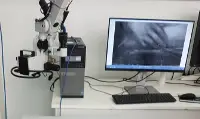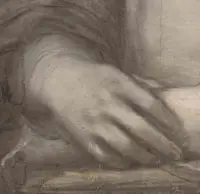|
'Nude Mona Lisa' May Be Leonardo Work, Experts Say
March 7, 2019 Scientists now say that Leonardo Da Vinci very well could have been the hand behind a charcoal drawing that looks very much like a nude Mona Lisa. 
The "Monna Vanna," as the drawing is known, has long been considered a product of Leonardo's studio, which featured many artists, but Leonardo himself wasn't thought to have been the one who did it. Scientists have painstakingly examined the work at a microscopic level at the C2RMF laboratory beneath the Louvre Museum and have come to the conclusion that is was likely Leonardo himself who created the drawing. Already exhibited or stored in museums around the world are nearly two dozen paintings of semi-clothed women who look like the Mona Lisa. One of the most well-known is the Dona Nuda, currently displayed at the Hermitage in St. Petersburg, Russia. The "Monna Vanna" looks very much like Leonardo's most famous painting, the Mona Lisa, from the way the woman is facing to the placement of her hands; the "Monna Vanna" is also similarly small, compared to other paintings done by Leonardo. The two works do have some significant differences. The woman in the drawing is not wearing clothing above the waist. Also, the drawing does not a defined background (as the mysterious one in the Mona Lisa, except for the dress that is wrapped around one of her arms. She is also facing slightly differently from the way that the subject of the Mona Lisa faces.
Now, scientists, after working for two years using high-tech equipment, say that they have found evidence that the "Monna Vanna" was drawn from top left to bottom right, suggesting that the artist was left-handed, which Leonardo was. The testing also revealed that the quality of the drawing was of the highest order, suggesting a master hand at work. 
The scientists had already ruled out the possibility that the charcoal drawing was a copy of a lost original because they found that the drawing was done using Leonardo's sfumato technique, a means of blurring or softening transitions between colors, creating an effect that makes something look just out-of-focus. The intensive work began in 2017, after another expert dated the charcoal drawing to the early 16th Century, around the time that Leonardo is known to have painted the Mona Lisa. The "Monna Vanna" is currently in the collection of the Condé Museum at the Chateau de Chantilly. The drawing will, later this year, be part of a display at that museum celebrating the life and work of the famous Renaissance Man; 2019 is the 500th anniversary of his death. Monna Vanna is also the title of a famous 19th-Century painting by Dante Gabriel Rossetti. Rossetti originally titled his painting Venus Veneta but changed it to Monna Vanna to reflect a character (a "vain woman") in of one of his favorite books, La Vita Nuova by Dante Alighieri. Monna Vanna is also the title of an unfinished opera by Sergei Rachmaninoff based on a play by Maurice Maeterlinck. The painting, opera, and play postdate the charcoal drawing "Monna Vanna" by a few hundred years. The Italian word mona translates into English as "my lady"; the Italian word monna is a variant of mona, and both are a contraction of Madonna, a formal title for a woman, similar to the English Madam. The Mona Lisa has sometimes been referred to as the Monna Lisa. |
|
Social Studies for Kids
copyright 2002–2024
David White







